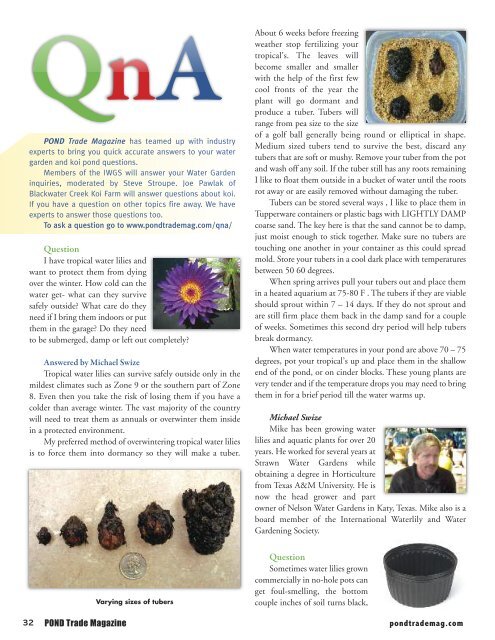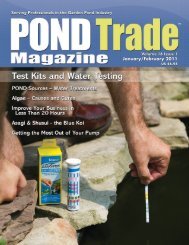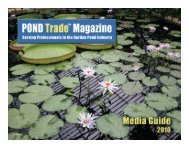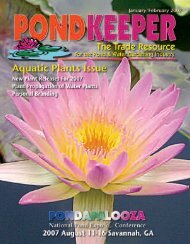Download the January/February 2010 PDF - Pond Trade Magazine
Download the January/February 2010 PDF - Pond Trade Magazine
Download the January/February 2010 PDF - Pond Trade Magazine
Create successful ePaper yourself
Turn your PDF publications into a flip-book with our unique Google optimized e-Paper software.
QnA<br />
POND <strong>Trade</strong> <strong>Magazine</strong> has teamed up with industry<br />
experts to bring you quick accurate answers to your water<br />
garden and koi pond questions.<br />
Members of <strong>the</strong> IWGS will answer your Water Garden<br />
inquiries, moderated by Steve Stroupe. Joe Pawlak of<br />
Blackwater Creek Koi Farm will answer questions about koi.<br />
If you have a question on o<strong>the</strong>r topics fire away. We have<br />
experts to answer those questions too.<br />
To ask a question go to www.pondtrademag.com/qna/<br />
Question<br />
I have tropical water lilies and<br />
want to protect <strong>the</strong>m from dying<br />
over <strong>the</strong> winter. How cold can <strong>the</strong><br />
water get- what can <strong>the</strong>y survive<br />
safely outside What care do <strong>the</strong>y<br />
need if I bring <strong>the</strong>m indoors or put<br />
<strong>the</strong>m in <strong>the</strong> garage Do <strong>the</strong>y need<br />
to be submerged, damp or left out completely<br />
Answered by Michael Swize<br />
Tropical water lilies can survive safely outside only in <strong>the</strong><br />
mildest climates such as Zone 9 or <strong>the</strong> sou<strong>the</strong>rn part of Zone<br />
8. Even <strong>the</strong>n you take <strong>the</strong> risk of losing <strong>the</strong>m if you have a<br />
colder than average winter. The vast majority of <strong>the</strong> country<br />
will need to treat <strong>the</strong>m as annuals or overwinter <strong>the</strong>m inside<br />
in a protected environment.<br />
My preferred method of overwintering tropical water lilies<br />
is to force <strong>the</strong>m into dormancy so <strong>the</strong>y will make a tuber.<br />
About 6 weeks before freezing<br />
wea<strong>the</strong>r stop fertilizing your<br />
tropical’s. The leaves will<br />
become smaller and smaller<br />
with <strong>the</strong> help of <strong>the</strong> first few<br />
cool fronts of <strong>the</strong> year <strong>the</strong><br />
plant will go dormant and<br />
produce a tuber. Tubers will<br />
range from pea size to <strong>the</strong> size<br />
of a golf ball generally being round or elliptical in shape.<br />
Medium sized tubers tend to survive <strong>the</strong> best, discard any<br />
tubers that are soft or mushy. Remove your tuber from <strong>the</strong> pot<br />
and wash off any soil. If <strong>the</strong> tuber still has any roots remaining<br />
I like to float <strong>the</strong>m outside in a bucket of water until <strong>the</strong> roots<br />
rot away or are easily removed without damaging <strong>the</strong> tuber.<br />
Tubers can be stored several ways , I like to place <strong>the</strong>m in<br />
Tupperware containers or plastic bags with LIGHTLY DAMP<br />
coarse sand. The key here is that <strong>the</strong> sand cannot be to damp,<br />
just moist enough to stick toge<strong>the</strong>r. Make sure no tubers are<br />
touching one ano<strong>the</strong>r in your container as this could spread<br />
mold. Store your tubers in a cool dark place with temperatures<br />
between 50 60 degrees.<br />
When spring arrives pull your tubers out and place <strong>the</strong>m<br />
in a heated aquarium at 75-80 F . The tubers if <strong>the</strong>y are viable<br />
should sprout within 7 – 14 days. If <strong>the</strong>y do not sprout and<br />
are still firm place <strong>the</strong>m back in <strong>the</strong> damp sand for a couple<br />
of weeks. Sometimes this second dry period will help tubers<br />
break dormancy.<br />
When water temperatures in your pond are above 70 – 75<br />
degrees, pot your tropical’s up and place <strong>the</strong>m in <strong>the</strong> shallow<br />
end of <strong>the</strong> pond, or on cinder blocks. These young plants are<br />
very tender and if <strong>the</strong> temperature drops you may need to bring<br />
<strong>the</strong>m in for a brief period till <strong>the</strong> water warms up.<br />
Michael Swize<br />
Mike has been growing water<br />
lilies and aquatic plants for over 20<br />
years. He worked for several years at<br />
Strawn Water Gardens while<br />
obtaining a degree in Horticulture<br />
from Texas A&M University. He is<br />
now <strong>the</strong> head grower and part<br />
owner of Nelson Water Gardens in Katy, Texas. Mike also is a<br />
board member of <strong>the</strong> International Waterlily and Water<br />
Gardening Society.<br />
Varying sizes of tubers<br />
Question<br />
Sometimes water lilies grown<br />
commercially in no-hole pots can<br />
get foul-smelling, <strong>the</strong> bottom<br />
couple inches of soil turns black,<br />
32 POND <strong>Trade</strong> <strong>Magazine</strong><br />
pondtrademag.com









